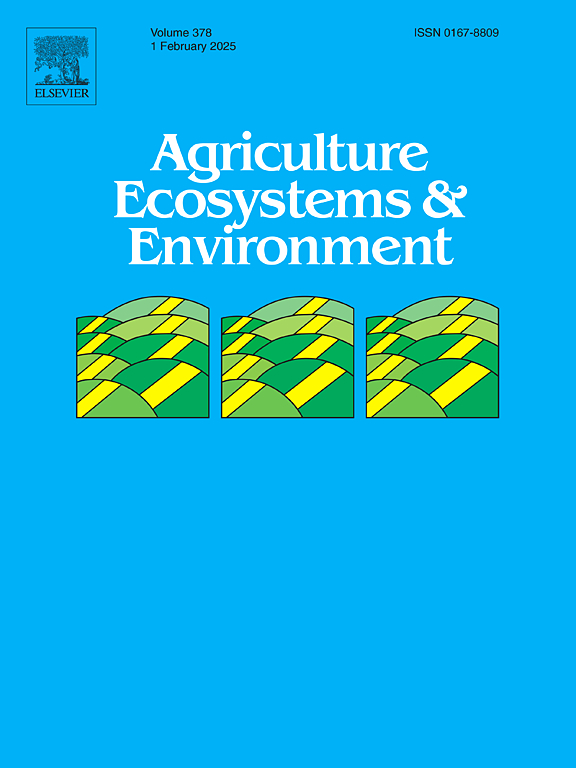2015年以来中国以减肥为主的农田N2O直接排放的拐点
IF 6
1区 农林科学
Q1 AGRICULTURE, MULTIDISCIPLINARY
引用次数: 0
摘要
为了保证足够的作物产量,中国的农田使用了大量的氮肥,导致农田土壤直接排放大量的一氧化二氮。自1980年以来,中国农业直接排放的一氧化二氮呈现出持续而显著的增长,这与农田面积的扩大和施肥措施的加强有关。然而,目前仍不确定N2O排放对近期以减少氮肥使用和调整作物组合为特征的农业政策的直接反应。缺乏明确性限制了对这些政策有效性的实际见解。为了填补这一空白,我们基于一个综合的N2O排放因子数据集和随机森林算法,对1980-2022年期间作物特定的N2O排放进行了更详细和及时的评估。由此估计的长期平均值为174.7 Gg N2O-N yr - 1,其中46 %来自主要作物(水稻、玉米和小麦),44 %来自三种经济作物(蔬菜、水果和茶叶)。1980—2015年,其变化趋势呈显著上升趋势,2015年达到峰值259.9 Gg N2O-N yr - 1, 2022年下降至215.3 Gg N2O-N yr - 1。全国范围内观察到的一氧化二氮排放趋势存在差异,超过四分之三的农田在2015年出现了拐点。氮的施用被认为是这一时间轨迹的根本驱动因素,尤其是在2015年之后的下降。本研究肯定了2015年以来以减肥增效为目标的行动所带来的巨大环境效益。它还为估算和减少全球农田一氧化二氮排放提供了有价值的见解。本文章由计算机程序翻译,如有差异,请以英文原文为准。
Turning point of direct N2O emissions in China’s croplands dominated by reduced fertilizer usage since 2015
Large amounts of nitrogen fertilizers have been applied into China’s croplands to ensure adequate crop production, leading to massive direct nitrous oxide (N2O) emissions from cropland soils. Since 1980, the agricultural direct N2O emissions in China have shown sustained and impressive growth, associated with the expansion of croplands and intensified fertilization practices. However, it remains uncertain how direct N2O emissions have responded to recent agricultural policies characterized by reducing N fertilizer use and adjusting crop mix. This lack of clarity limits practical insights into the effectiveness of these policies. To fill this gap, we here provided a more detailed and timely assessment of crop-specific N2O emissions during 1980–2022 based on a comprehensive N2O-emission factor dataset and the random forest algorithm. The resulting estimation exhibited a long-term average of 174.7 Gg N2O-N yr−1, with 46 % of it contributed by staple crops (rice, maize and wheat) and 44 % from three cash crops (vegetables, fruit and tea). The temporal sequences revealed a noticeable increase over 1980–2015, peaking in 2015 at 259.9 Gg N2O-N yr−1, followed by a subsequent decline to 215.3 Gg N2O-N yr−1 by 2022. The divergent trends of N2O emissions were observed countrywide, with the turning point at 2015 recognized across more than three-quarter croplands. N application was identified as the fundamental driver for this temporal trajectory, especially the decline after 2015. This study affirms the great environmental benefits from the actions targeted at reducing fertilizer usage and enhancing efficiency since 2015. It also provides valuable insights for estimating and mitigating global N2O emissions from croplands.
求助全文
通过发布文献求助,成功后即可免费获取论文全文。
去求助
来源期刊

Agriculture, Ecosystems & Environment
环境科学-环境科学
CiteScore
11.70
自引率
9.10%
发文量
392
审稿时长
26 days
期刊介绍:
Agriculture, Ecosystems and Environment publishes scientific articles dealing with the interface between agroecosystems and the natural environment, specifically how agriculture influences the environment and how changes in that environment impact agroecosystems. Preference is given to papers from experimental and observational research at the field, system or landscape level, from studies that enhance our understanding of processes using data-based biophysical modelling, and papers that bridge scientific disciplines and integrate knowledge. All papers should be placed in an international or wide comparative context.
 求助内容:
求助内容: 应助结果提醒方式:
应助结果提醒方式:


